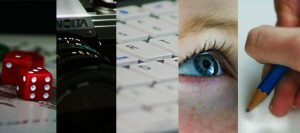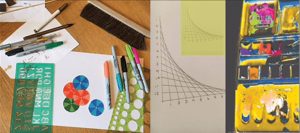Fixation on a known idea or on a known way of solving a problem is a commonly observed phenomenon in creativity and design. Often, attachment to initial ideas or repeating solutions or parts thereof is seen as a negative thing. But does it always lead to worst outcomes? Researchers are not so sure about it.
We have seen a form of fixation in a recent competition for the Web banner for our new Design and Innovation Qualification website (requires OU credentials). We had around 30 entries and a group of 14 staff rated the entries on a scale from 0-10. The criterion was how well the banner represents design and innovation.
To my surprise, the winner, second and third runner-up all used a similar way of putting together images that conjured Design and Innovation for them. This made me think. In the design brief, we gave two examples of banners that were used on other qualifications and the three winners were similar in arrangement to one of the examples. A classic case of fixation. But the results were good!

Patience Heath

Kelly Moir

Helen Donoghue
Congratulations to the winners!
Repeating an idea, often unconsciously or even unknowingly, is a basic human learning mechanism. Think about the saying: ‘not to re-invent the wheel’. The positive effects of this kind of bias include saving time, costs and resource. Fixation may represent a form of best practice. Good fixation can be used in is teaching designing, too. We often teach through examples or cases that are worth keeping in mind.
What do you think? Can fixation in design be positive?

Leave a Reply